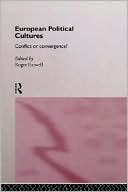

 |

|

The average rating for European Political Cultures based on 2 reviews is 3.5 stars.
Review # 1 was written on 2019-11-12 00:00:00 Jon Julian Ferguson Jon Julian FergusonWhen a copy of this text arrived unsolicited from the publisher, it nearly met the fate of most other such books unrelated to my historical specialties. Nevertheless, flipping through the volume revealed an enthusiasm and a writing style that encouraged further investigation. On her website, Kaborycha admits disliking textbooks, and that distaste probably encouraged her to work harder at writing engaging prose. I wouldn't call the presentation scintillating, but it's certainly very good, especially in light of recent survey texts heavy on glitz, light on substance, and drearily written. Sometimes Kaborycha even exhibits first-rate descriptive powers, as in her introduction to Renaissance Venice (139).I learned a great deal from this book, even a few things that I squirreled away at the bottom of lecture notes. Nevertheless, there are the gremlins that typically bedevil first editions of textbooks (see, for instance, the duplication in the first paragraph on page 114) and some odd conjunctures, such as including Castiglione in the chapter on the sack of Rome. The author has also made a common error of placing Galileo's death and Newton's birth in the same year. (It only works if you calculate in both Old Style and New Style calendars at the same time; there's actually a year between those events.) Nevertheless, the greatest problem with the book is its lack of illustrations. I'm all too aware of the potential cost, but as an older teacher who's taken more than his share of turns at History of Civ, I can attest that it's impossible to effectively discuss Renaissance art without at least small black-and-white reproductions. |
Review # 2 was written on 2016-09-21 00:00:00 Jesse Waggoner Jesse WaggonerThe author very sensibly uses BCE and CE for the dating system in this book, rather than the antiquated BC and AD system that many modern historians still very embarrassingly use. This book is clearly written for students, but that doesn't detract from the work. As the title rather strongly suggests, this is meant to be little more than an introduction to the complex subject of Renaissance Italy. Instead of having a single bibliography listed at the back of the book, the author has a bibliography listed at the end of each chapter. The reason is that each chapter targets specific aspects or Renaissance Italy, so the bibliographies are relevant to the topics covered in each chapter. To be honest, though, I would have still liked an overall bibliography at the end of the book. The author has a bit of an odd habit of sometimes writing the Italian for the century instead of simple English; for example, Duecento instead of thirteenth century. What makes it odd is that it's not consistent, so sometimes she uses Italian, sometimes English. Since this book was never meant to be an Italian language guide, I would have preferred that she simply stuck to the English for the sake of ease and simplicity, especially since this was aimed especially at students. But even though it was indeed primarily written with students in mind, there's absolutely no reason why non-students like me can't read it. It's a very good introduction to the subject. |
CAN'T FIND WHAT YOU'RE LOOKING FOR? CLICK HERE!!!